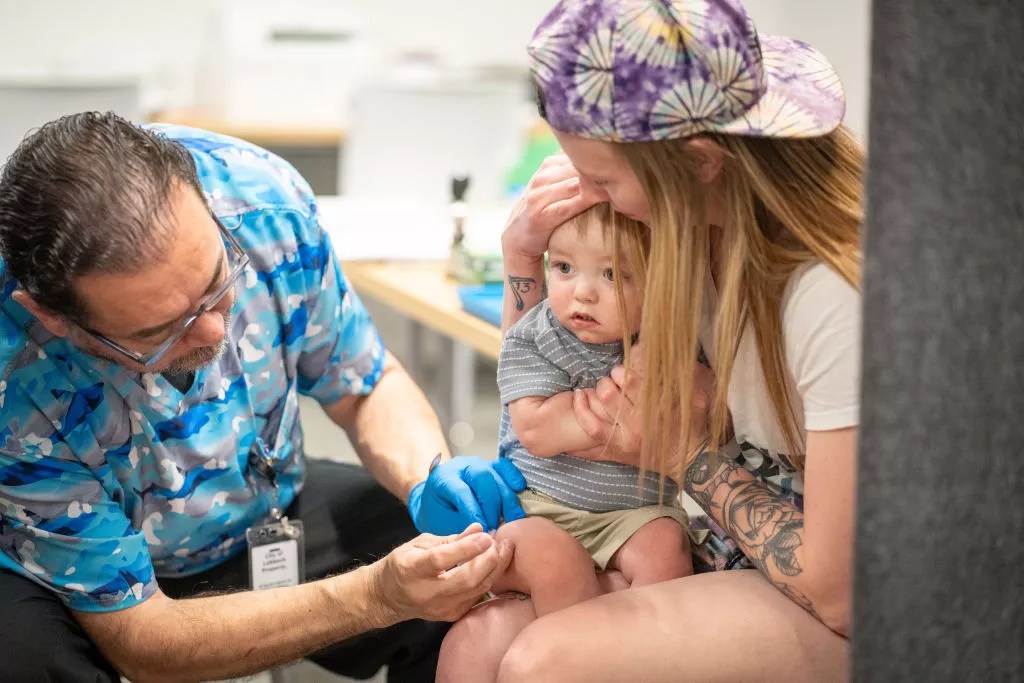
Sarah Ventre

Audio By Carbonatix
Editor’s note: This story was published Nov. 11 and updated Nov. 12 with new measles case numbers.
***
As measles cases popped up across the United States earlier this year, experts warned that an outbreak in Arizona was inevitable. Now, a steadily growing outbreak along the Arizona-Utah border has become the second-largest in the nation, according to the University of Minnesota’s Center for Infectious Disease Research and Policy.
More than 180 positive measles cases have been connected to the outbreak, which is centered on the twin towns of Colorado City, Arizona, and Hildale, Utah. The area, known as Short Creek by locals, is relatively isolated and has low vaccination rates. A total of 124 cases have been reported by the Mohave County Health Department, which includes Colorado City. Another 58 cases have been reported by the Southwest Utah Public Health Department.
This year, make your gift count –
Invest in local news that matters.
Our work is funded by readers like you who make voluntary gifts because they value our work and want to see it continue. Make a contribution today to help us reach our $30,000 goal!
The two towns have a combined population of about 5,000. All the cases in both jurisdictions have been traced back to the Short Creek outbreak.
The only larger outbreak of measles this year — a resurgent one for measles — was in Texas. The outbreak, concentrated in West Texas’s Gaines County, began in late January and resulted in more than 760 people testing positive for the highly contagious disease. Nearly 100 people were hospitalized, and two school-aged children who lived in the area died. After seven months, the Texas Department of State Health Services announced that the outbreak had ended, as no new cases had been reported for more than 42 days.
The West Texas outbreak accounts for a significant portion of the total 1,681 measles cases reported nationwide this year, according to the Centers for Disease Control and Prevention. Cases have been reported in 41 states. Arizona saw its first measles cases earlier this year when four cases popped up in Navajo County. Those cases, which are unrelated to the Short Creek outbreak, did not spread.
No one has died of measles in Short Creek, which may not have enough residents for its outbreak to approach Texas’ numbers. But the number of cases continues to grow, suggesting the outbreak is far from petering out.
“Our hope is that the numbers stay low,” said Dave Heaton, the Southwest Utah Public Health Department’s public information officer. “I don’t want to downplay it, but it looks like we’re kind of at a distant second. We hope that’s where it stays, that it won’t really expand beyond the numbers that we have now.”
Measles is one of the most contagious diseases known to man. A positive case can be identified by a red rash that appears on the face and travels down the rest of the body, as well as by white spots in the mouth. Patients can develop a high fever, which can lower their immune system and allow other diseases, such as pneumonia and encephalitis, to infiltrate and take hold, sometimes with deadly consequences.
Eight people have required hospitalization as a result of the Short Creek measles outbreak, although there have likely been other cases that required medical intervention but didn’t result in a hospital stay. Unvaccinated people of all ages, from infants to adults, have been among the positive cases; however, the majority have been among school-aged children. On the Utah side, only one case was a “breakthrough” case, involving a vaccinated person who contracted measles.

Jan Sonnenmair/Getty Images
Could get worse
The disease has been spreading there for more than three months, helped along by residents’ vaccine hesitancy. The area used to be the stronghold of the polygamous Fundamentalist Church of Jesus Christ of Latter-day Saints and the church’s leader and prophet, Warren Jeffs. Today, mostly former church members reside in the community, which has changed significantly over the last two decades.
At the beginning of October, New Times visited Short Creek to report on the outbreak and the area’s attempt to break free from Jeffs’ influence.
The measles, mumps and rubella vaccine is 97% effective in preventing the spread of the disease after two doses. But years ago, many residents did not get vaccinated at Jeffs’ direction, and others are suspicious of the government telling them what to do. It takes a vaccination rate of 95% to achieve herd immunity from measles, but Short Creek’s vaccination rate was well below that threshold when the outbreak began. Only 80% of students at Hildale’s high school were vaccinated, and the school has had several measles cases. Just 40% of students at Colorado City’s high school were vaccinated, while the area’s charter school had a vaccination rate of just 7.7%.
Local health officials on both sides of the state border are collaborating to limit the spread and encourage residents to get vaccinated. Currently, the Southwest Utah Health Department is focusing its messaging toward parents who have been hesitant to vaccinate their children to “encourage” them to vaccinate their children, Heaton said. Children, especially young children, are highly susceptible to the adverse effects of measles.
Since the beginning of the outbreak, the Mohave County nursing station and the Creek Valley Health Clinic, the only two locations in the immediate area where Short Creek residents can receive their shots, have administered more than 725 doses of the vaccine, Creek Valley CEO Hunter Adams told New Times in an email.
“We don’t sense a lot of worry in our community because people are either vaccinated or folks who decided not to are pretty firm on that stance,” Heaton said. “So we’re looking for that group of parents who we can message to hopefully encourage in that direction.”
The outbreak likely won’t end until either everyone gets vaccinated or measles “exposes who it’s gonna expose and those people recover,” Heaton said. “This may be a timing issue of waiting it out once we’ve convinced all the people to get vaccinated.”
Typically, children don’t receive their first dose of the MMR vaccine until they’re one year old. But with cases continuing to steadily rise, the Southwest Utah Public Health Department is recommending that parents vaccinate their children with the measles vaccine as young as six months, “just to protect them,” Heaton said. Additionally, with cold and flu season approaching, public health officials are concerned that the measles outbreak could worsen. As more people gather in their homes to celebrate the holiday season, this could be a “potential recipe for an increase in the outbreak,” Heaton said.
“Our main concern is that the more cases you have, the more chance there is of a vulnerable person, especially a small child, having severe effects,” Heaton said.